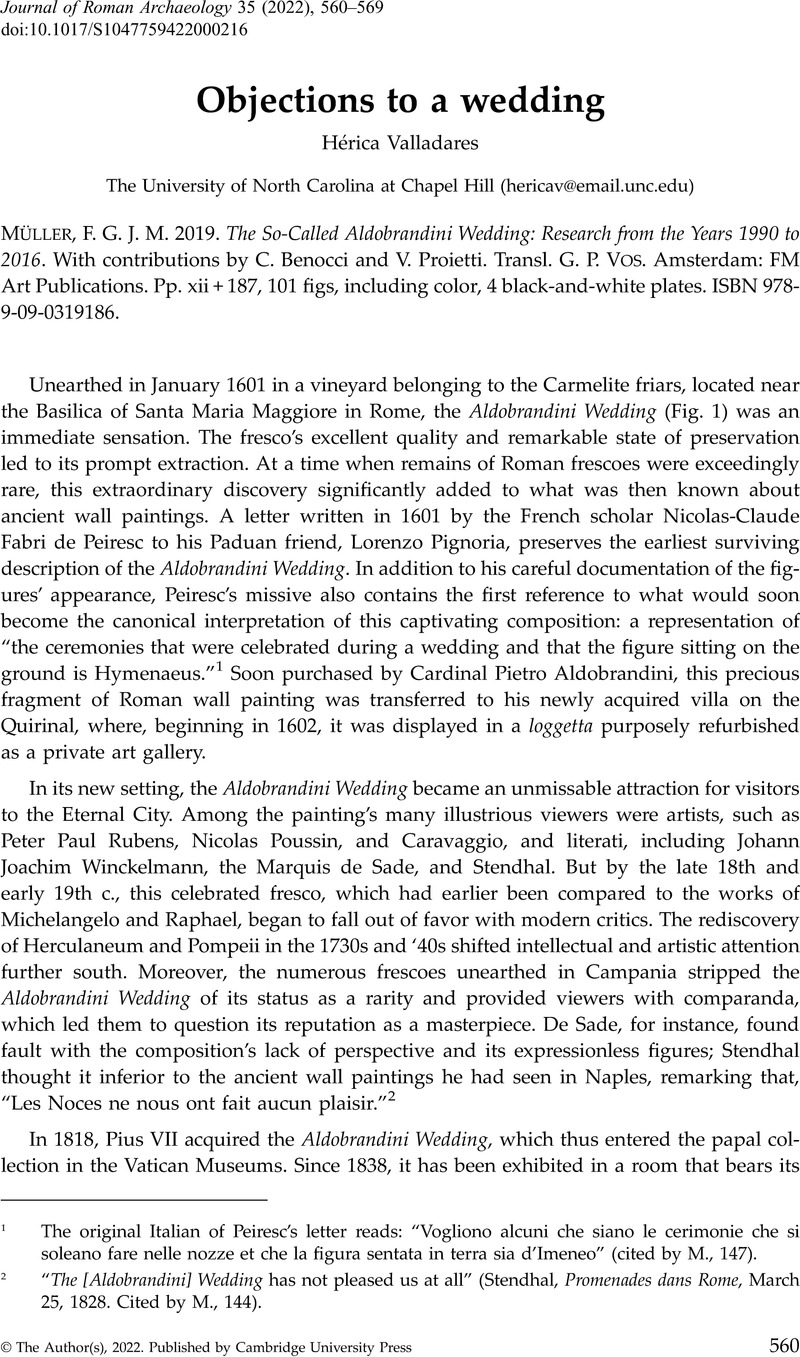No CrossRef data available.
Article contents
Objections to a wedding - F. G. J. M. Müller 2019. The So-Called Aldobrandini Wedding: Research from the Years 1990 to 2016. With contributions by C. Benocci and V. Proietti. Transl. G. P. Vos. Amsterdam: FM Art Publications. Pp. xii + 187, 101 figs, including color, 4 black-and-white plates. ISBN 978-9-09-0319186.
Review products
F. G. J. M. Müller 2019. The So-Called Aldobrandini Wedding: Research from the Years 1990 to 2016. With contributions by C. Benocci and V. Proietti. Transl. G. P. Vos. Amsterdam: FM Art Publications. Pp. xii + 187, 101 figs, including color, 4 black-and-white plates. ISBN 978-9-09-0319186.
Published online by Cambridge University Press: 19 May 2022
Abstract
An abstract is not available for this content so a preview has been provided. Please use the Get access link above for information on how to access this content.

- Type
- Book Review
- Information
- Copyright
- Copyright © The Author(s), 2022. Published by Cambridge University Press
References
Amedick, R. 1999. Review of Iconological Studies in Roman Art, by F. G. J. M. Müller. Gnomon 71: 56–60.Google Scholar
Anguissola, A. 2012. “Difficillima Imitatio”: immagine e lessico delle copie tra Grecia e Roma. Rome: “L'Erma” di Bretschneider.Google Scholar
Balty, J. 1997. Review of Iconological Studies in Roman Art, by F. G. J. M. Müller. AntCl 66: 689–91.Google Scholar
Beard, M., and Henderson, J.. 2001. Classical Art: From Greece to Rome. Oxford: Oxford University Press.Google Scholar
Bergmann, B. 1995. “Greek masterpieces and Roman recreative fictions.” HSCP 97: 79–120.Google Scholar
Blanckenhagen, P. von, and Green, B.. 1975. “The Aldobrandini Wedding reconsidered.” MdI 82: 83–98.Google Scholar
Cappelletti, F., and Volpi, C.. 1993. “New documents concerning the discovery and early history of the Nozze Aldobrandini.” JWarb 56: 274–79.Google Scholar
Conte, G. B. 1994. Latin Literature: A History. Transl. J. B. Solodow. Baltimore: Johns Hopkins University Press.Google Scholar
Elsner, J. 2020. “Mutable, flexible, fluid: Papyrus drawings for textiles and replication in Roman art.” ArtB 102: 7–27.Google Scholar
Fusconi, G. 1994. La fortuna delle “Nozze Aldobrandini.” Dall'Esquilino alla Biblioteca Vaticana. Città del Vaticano: Biblioteca Apostolica Vaticana.Google Scholar
Gazda, E., ed. 2002. The Ancient Art of Emulation: Studies in Artistic Originality and Tradition from the Present to Classical Antiquity. Ann Arbor: Michigan University Press.CrossRefGoogle Scholar
Gazda, E. 2021. “Portraits and patrons: The women of the Villa of the Mysteries in their social context.” In Women's Lives, Women's Voices: Roman Material Culture and Female Agency in the Bay of Naples, ed. Longfellow, B. and Swetnam-Burland, M., 133–50. Austin: The University of Texas Press.Google Scholar
Häuber, C. 2014. The Eastern Part of the Mons Oppius in Rome: The Sanctuary of Isis et Serapis in Regio III, the Temples of Minerva Medica, Fortuna Virgo and Dea Syria, and the Horti of Maecenas. Rome: “L'Erma” di Bretschneider.Google Scholar
Hersch, K. 2010. The Roman Wedding: Ritual and Meaning in Antiquity. Cambridge and New York: Cambridge University Press.CrossRefGoogle Scholar
Hölscher, T. 2004. The Language of Images in Roman Art. Transl. Snodgrass, A. and Künzl-Snodgrass, A.. Cambridge and New York: Cambridge University Press.Google Scholar
Holzberg, N. 1997. “Playing with his life: Ovid's ‘autobiographical’ references.” Lampas 30: 4–19.Google Scholar
Jones, N. 2019. Painting, Ethics and Aesthetics in Rome. Cambridge and New York: Cambridge University Press.CrossRefGoogle Scholar
Joyce, H. 1992. “Grasping at shadows: Ancient paintings in Renaissance and Baroque Rome.” ArtB 74: 219–46.Google Scholar
Kilpatrick, R. 2002. “The Early Augustan Aldobrandini Wedding fresco: A quatercentenary reappraisal (1601–2001).” MAAR 47: 19–32.Google Scholar
Knox, P., ed. 1995. Ovid: Heroides. Select Epistles. Cambridge and New York: Cambridge University Press.Google Scholar
Marvin, M. 2008. The Language of the Muses: The Dialogue Between Roman and Greek Sculpture. Los Angeles: J. Paul Getty Museum.Google Scholar
Papini, M. 2010. “Le Nozze Aldobrandini: un matrimonio romano e il rito dell’aqua et igni accipi.” BMonMusPont 27: 65–104.Google Scholar
Pearson, S. 2015. “Bodies of meaning: Figural repetition in Pompeian painting.” In Beyond Iconography: Materials, Methods, and Meaning in Ancient Surface Decoration, ed. Lepinski, S. and McFadden, S., 149–66. Boston: Archaeological Institute of America.Google Scholar
Perry, E. 2005. The Aesthetics of Emulation in the Visual Arts of Ancient Rome. Cambridge and New York: Cambridge University Press.Google Scholar
Smith, R. R. R. 1988. Hellenistic Royal Portraits. Oxford and New York: Oxford University Press.Google Scholar
Swetnam-Burland, M. 2015a. Egypt in Italy: Visions of Egypt in Roman Imperial Culture. Cambridge and New York: Cambridge University Press.CrossRefGoogle Scholar
Swetnam-Burland, M. 2015b. “Encountering Ovid's Phaedra in House V.2.10–11, Pompeii.” AJA 119: 217–32.CrossRefGoogle Scholar
Valladares, H. 2007. “Four women from Stabiae: Eighteenth-century antiquarian practice and the history of ancient Roman painting.” In Antiquity Recovered: The Legacy of Pompeii and Herculaneum, ed. Coates, V. and Seydl, J., 73–94. Los Angeles: J. Paul Getty Museum.Google Scholar
Valladares, H. 2011. “Fallax Imago: Ovid's Narcissus and the seduction of mimesis in Roman wall painting.” Word & Image 27: 378–95.CrossRefGoogle Scholar
Valladares, H. 2021. Painting, Poetry, and the Invention of Tenderness in the Early Roman Empire. Cambridge and New York: Cambridge University Press.Google Scholar
Wesenberg, B. 1988. “Zur Io des Nikias in den pompejanischen Wandbildern.” In Kanon. Festschrift Ernst Berger zum 60. Geburtstag am 26. Februar 1988 gewidmet, ed. Schmidt, M. and Berger, E., 344–50. Basel: Vereinigung der Freunde antiker Kunst.Google Scholar
Zanker, P. 1990. The Power of Images in the Age of Augustus. Transl. Shapiro, A.. Ann Arbor: Michigan University Press.Google Scholar




